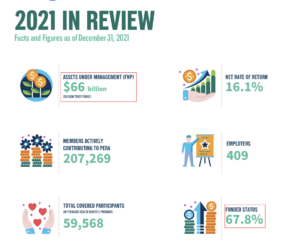What happens when the government decides you aren’t smart enough to handle more than a simple, direct, but incomplete story? What happens when that story is about an enterprise big enough to sink the state’s finances?
In 2018, Colorado’s legislature passed Senate Bill 200, a comprehensive reform of the state’s Public Employees Retirement Association (PERA). The legislature acted because credit rating agencies had informed the markets that Colorado’s chronically troubled pensions had the potential to affect the state’s credit worthiness.
The stated goal was to have the pensions fully funded by 2048. To monitor progress toward that goal, the law established a joint legislative subcommittee composed of four legislators and nine appointed citizen experts. The panel is charged with asking critical questions of PERA and with making recommendations to the board and the legislature’s Pension Review Committee. I serve as the Republican House Minority appointee on that committee.
The subcommittee also writes an annual letter to the citizens of the state detailing progress toward that all-important funding goal. The letter includes, among other things, PERA’s funded ratio and whether the amortization period – based on a constant rate of return – indicates full funding by the 2048 target date.
But PERA also reports the year-end market value of its assets in the actuarial section of its Comprehensive Annual Financial Report (CAFR). This year, that number happens to be lower than the smoothed assets, so its funded ratio using the market value would be lower. Since actuarial smoothing recognizes pension returns over a four-year period rather than all at once, it is less vulnerable to sharp annual changes. But it also means that the funded ratio can actually increase in years following poor returns.
In addition, PERA’s actuary runs a statistical Monte Carlo simulation (the “Signal Light Report”) to estimate the likelihood of reaching full funding on time. This year, the report differs significantly from PERA’s confident assertion. It gives the two largest divisions, for school and sate government retirees, a little better than 40% chance of reaching full finding by 2048, estimating a more likely date as 2068, a generation later. Clearly, the Signal Light Report tells you the most in years when it differs from PERA’s standard model.
In the Monday, August 28 meeting, I proposed adding three elements to the letter to Colorado’s citizens. First, the previous year’s rate of return, and the average return over the last 30 years. Second, the market value of assets at the end of the fiscal year and the funded ratio based on that number. Finally, a one-line summary of the Signal Light report stating the expected date of full-funding and the simulation’s estimate of how likely a 2048 target date was.
Nowhere did I propose removing existing information, only to provide additional, relevant information to taxpayers who are on the hook for PERA commitments.
The Republicans on the committee differed in their assessments of each motion; the Democrats voted lock-step against all of them, arguing that the data was irrelevant and it would simply confuse citizens.

Particularly hostile to the idea was a former president of the Boulder Valley Education Association and elected member of PERA’s Board of Trustees from 2017-2022, Tina Mueh. Her opposition was ironic, because in her time on the Board, she voted to “confuse” people in exactly the same way as she opposed in committee.
The ‘year in review’ page the Board started to include in the CAFR during her tenure is shown in figure 1.
The Assets Under Management are the end-of-year market value, while the Funded Status is calculated with the smoothed asset value. Note that neither is labeled.
PERA’s CAFR deservedly receives awards for organization, clarity, and completeness. The Board’s decision to include that “confusing” information stand outs by contrast.
Mrs. Mueh is also now a candidate for partisan office, something that was officially announced after she joined the subcommittee, and never mentioned in meetings. This is not a legal issue – subcommittee member Lang Sias ran for state treasurer last year. But her time on the Board is a significant presence on her campaign website.
Possessed of the teachers unions’ traditional hostility to transparency and attachment to the unsustainable defined benefit pension model, Mueh also made noises about removing the per-person unfunded liability. That number has been one of the most effective tools nationally in alerting people to the state of public pensions. It is included in the letter by law. The content of one of Mrs. Mueh’s bills, should she be elected, is left as an exercise to the reader.
A committee dedicated to impartial pension financial analysis cannot survive political agendas designed to shield a pension from scrutiny.
Joshua Sharf is senior fellow in fiscal policy at the Independence Institute, a free market think tank in Denver.


